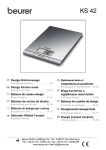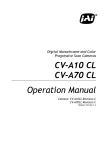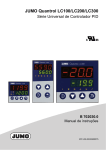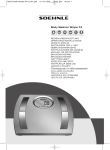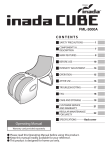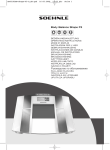Download Beurer BF 66 Operating instructions
Transcript
BF66 D Diagnose-Waage I Gebrauchsanweisung ...................... 2-14 GB Diagnostic scale Istruzioni per l´uso.....................54-66 TR Instruction for Use.......................... 15-27 F Pèse-personne impédancemétre Báscula para diagnóstico Instrucciones para el uso ............... 41-53 Diyagnoz terazisi Kullanma TalimatÕ .....................67-79 RUS Ⱦɢɚɝɧɨɫɬɢɱɟɫɤɢɟ ɜɟɫɵ ɂɧɫɬɪɭɤɰɢɹ ɩɨ ɩɪɢɦɟɧɟɧɢɸ....80-92 Mode d´emploi ............................... 28-40 E Bilancia diagnostica PL Waga diagnostyczna Instrukcja obsáugi ....................93-108 Beurer GmbH • Söflinger Str. 218 • D-89077 Ulm (Germany) Tel.: ++49 (0) 731 / 39 89-144 • Fax: ++49 (0) 731 / 39 89-255 www.beurer.de • Mail: [email protected] English Dear Customer, Thank you for choosing one of the products. Our name stands for high-quality, thoroughly tested products for applications in the areas of heat, weight, blood pressure, body temperature, pulse, gentle therapy, massage and air. Please read these instructions for use carefully and keep them for later use, be sure to make them accessible to other users and observe the information they contain. This diagnostic scale is designed to make a significant contribution to your health. The scale offers the following functions for use by a maximum of 10 persons: x Measuring and monitoring weight. x Calculating body fat, body water and muscle percentages, bone mass, basal metabolic rate and active metabolic rate. x The diagnostic scale has an innovative display that shows the required measured value at the press of a button. Your scale has four basic functions: Function Description Weight only Weight measurement only Complete analysis Complete measurement with automatic sequential display of all measured values Target analysis Complete measurement, display of weight and selected measured values Memory Retrieve stored measurements (max. 10) With kind regards Your Beurer team 15 1 Included in delivery x Diagnostic scale BF66 x 3 x 1.5 V, type AAA (LR03), microlight batteries x These operating instructions 2 Signs and symbols The following symbols appear in these instructions. Warning Warning instruction indicating a risk of injury or damage to health. Important Safety note indicating possible damage to the device/accessory. Note 3 Note on important information. Device description Overview 1 2 3 Electrodes made from conductive rubber Display Function and setting buttons Function buttons Weight Body fat Body water Muscle percentage Bone mass Basal metabolic rate BMR Active metabolic rate AMR 1 2 3 4 5 6 7 Setting buttons 8 9 10 16 T S/ set Down Up / User Confirm setting 4 Notes Safety notes x The scales must not be used by persons with medical implants (e.g. heart pacemakers) Otherwise their function could be impaired. x Do not use during pregnancy. Measurements may be inaccurate due to amniotic fluid. x Do not stand on the outer edge to one side of the scale otherwise it may tip! x Keep children away from packaging materials (risk of suffocation). Notes on handling batteries x Swallowing batteries can be extremely dangerous. Keep the batteries and scale out of the reach of small children. Should a child swallow a battery, seek medical assistance immediately. x Replace weak batteries before they discharge completely. x Batteries must not be recharged, taken apart, thrown into an open fire or short circuited. x Always replace all batteries at the same time and use batteries of the same type. x Leaking batteries may damage the device. If you do not intend to use the scale for longer periods, remove the batteries from the battery compartment. x If a battery has leaked, put on protective gloves and clean the battery compartment with a dry cloth. x Batteries can contain toxins that are harmful to health and the environment. Always dispose of batteries in accordance with applicable legal regulations. Do not dispose of batteries with the normal household waste. General notes x x x x x x x x x x x The unit is for personal use only and is not intended for medical or commercial applications. Please note that technically related measuring tolerances are possible, as the scale is not calibrated for professional medical applications. The capacity of the scale is 150 kg (330 lb, 24 St). For weight measurement and bone mass measurement, the results are shown in 100 g increments (0.2 lb, 1/4 St). The measuring results of the body fat, body water and muscle percentage are shown in 0.1% increments. On delivery, the scale is set to "cm" and "kg". At the back of the scales is a switch to change between "inches", "pounds" and "stones". Place the scale on a firm level floor; a firm floor covering is required for correct measurement. The scale should be cleaned occasionally. Dirt and dust has a tendency to collect on the rubber electrodes. Always stand on the scale barefoot or wearing socks as the rubber surfaces will quickly become dirty if you wear shoes. Use a damp cloth to clean the scale. Do not use abrasive detergents and never immerse the scale in water. Protect the scale against hard knocks, moisture, dust, chemicals, major temperature fluctuations and heat sources which are too close (stoves, heating radiators). Repairs may only be carried out by Beurer customer service or authorised dealers. Before submitting any complaint, first check the batteries and replace them if necessary. Should you have any questions concerning the use of our scale, please contact your dealer or customer service. All scales comply with EC Directive 2004/108/EC. Should you have any questions concerning the use of our scale, please contact your dealer or customer service. 17 5 Information The measuring principle This scale operates according to the B.I.A. principle (bioelectric impedance analysis). This enables the measurement of physical relationships within seconds by means of an undetectable, completely harmless electric current. The body fat percentage and other physical relationships in the body can be determined by measuring the electrical resistance (impedance) and calculating constants and individual parameters such as age, height, gender and degree of activity. Muscle tissue and water have good electrical conductivity, and therefore lower resistance. Bones and fatty tissue, on the other hand, have low conductivity as fat cells and bones conduct hardly any current as a result of their very high resistance. Please be aware that values obtained from the diagnostic scale represent only an approximation of actual analytical medical data. Only a specialist physician can accurately determine body fat, body water, muscle percentage and bone structure using medical procedures (e.g. computed tomography). General tips x If possible, always weigh yourself at the same time of day (preferably in the morning), after using the toilet, on an empty stomach and unclothed, in order to achieve comparable results. x Important for the measurement: only measure body fat when barefoot and with the soles of the feet slightly moist. Completely dry soles can result in unsatisfactory measurements due to inadequate conductivity. x Stand still and upright during the measurement. x Wait a few hours after unaccustomed physical activity. x Wait approx. 15 minutes after getting up in the morning to allow the water in the body to distribute. x Remember that only long-term trends are important. Short-term changes in weight within a few days are usually caused by a loss of fluid. Body water plays an important role towards our general wellbeing. Limitations When measuring body fat and other values, deviating and implausible results may occur in: x x x x children under approx. 10 years, competitive athletes and body builders, pregnant women, persons with fever, undergoing dialysis treatment or with symptoms of edema or osteoporosis, x persons taking cardiovascular medication (affecting the heart and vascular system), x persons taking vascular dilating or vascular constricting medication, x persons with considerable anatomic deviations of the legs in relation to total body size (length of the legs considerably shortened or lengthened). 18 6 Batteries Remove the batteries from the protective packaging and insert with the correct polarity. See the diagram inside the battery compartment. When the batteries are inserted, the scale switches on automatically in set-up mode (see Point 7). The date display flashes. If the scale fails to operate, remove the batteries completely and reinsert them. Your scale is fitted with a "change battery" indicator. If the scale is operating with a battery which is too weak, "Lo" appears on the display and the scale will switch off automatically. In this case, the batteries must be replaced (3 x 1.5 V, AAA (LR03), microlight). 7 Settings Enter your personal information before using the scale. If no buttons are pressed for 90 seconds during the set-up procedure, the scale switches off and any information previously entered is lost. Setting the date, time and measuring unit Press the [set] button when the display is switched off. The [set] button lights up and the date indicator flashes on the display. Set the date, time and measuring unit (KG, LB, ST) one after the other by pressing the S or T buttons. x Modifying values: Press S or T or press and hold for more rapid progress. x Confirming entries: Press the [set] button. After your entries are made, "End" appears on the display and the information is saved. Setting user data You must enter personal user parameters in order to measure your body fat percentage and other physical data. The scale has 10 memory positions in which you and other members of your family can save and retrieve personal settings. x Switch on the display by tapping the scale briefly, forcefully and in an easily audible manner. x Wait until the display shows "0.0". x Press the [set] button to start changing the settings. The first memory position flashes on the display. x Now you can enter the following settings: User data Memory position Body size Age Sex Degree of activity Parameters 1 to 10 100 to 220 cm (3' 3" to 7' 3") 10 to 100 years male , female 1 to 5 x Modifying values: Press S or T or press and hold for more rapid progress. x Confirming entries: Press the [set] button. The saved values are then displayed one after the other. The scale is now ready for measurement. The scale switches off automatically if no other actions are performed. 19 Degrees of activity Selection of the degree of activity must refer to the medium and long term. Degree of Physical activity activity 1 None. 2 Low: A small amount of light physical effort (e.g. short walks, light garden work, gymnastic exercises). 3 Medium: Physical effort for 30 minutes at least 2 to 4 times a week. 4 High: Physical effort for 30 minutes at least 4 to 6 times a week. 5 Very high: Intensive physical effort, intensive training or hard physical work for at least one hour daily. After all parameters have been entered, you can now measure your weight, body fat and the other data. 8 Operation Taking measurements x Select the desired function and activate the scale as follows: Function Activation Weight only Press the button or tap the scale briefly, forcefully and in an easily audible manner using your foot Complete analysis Press the S / button (or or tap the scale briefly, forcefully and in an easily audible manner using your foot and the press the S / button) Target analysis Press the function button The display switches on and the date and time appear. x Wait until "0.0 KG" appears on the display. x When using the analysis functions, press the S / button to select the user. x Now step barefoot onto the scale. Stand still with your weight distributed evenly on both legs. The scale will start measuring your weight immediately and a short time later will display your weight. Important: When activating the analysis functions, make sure there is no contact between your feet, legs, calves or thighs. Otherwise the measurement will not be performed correctly. x When you step off the scale, the scale will switch off after a few seconds. 20 Results display "Weight only" function The "Weight only" function only displays the measured weight (the last weight measured, trend displays and interpretations are not displayed). Analysis functions "Complete analysis and target analysis" The analysis functions display more detailed results: 1 2 3 4 Current measurement Last measurement Average value of the last 5 measurements Interpretation: comparison with table values 3 2 1 4 The "Complete analysis" function displays the results automatically in sequence (one after the other), the illuminated function key indicates the measured variable: 1 2 3 4 5 6 7 Weight Body fat Body water Muscle percentage Bone mass Basal metabolic rate BMR Active metabolic rate AMR Complete analysis function KG, LB or ST % % % KG, LB or ST Kcal Kcal Press any function key to display the results more quickly or individually. If you pressed one of the function buttons to start the measurement for a "Target analysis", only the weight and the selected result are displayed. Target analysis function In this case, the results are not displayed automatically in sequence. However, you can also press one of the other function keys to retrieve these results. 21 Memory function x x x A maximum of 10 sets of results are saved automatically in the measured value memory. Incorrect measurements resulting in "Err" are not saved. Weight measurements (without analysis measurement) are not saved in the memory. Retrieving measured values from the memory The last 10 measurements can be retrieved. x Switch on the scale by tapping the scale briefly, forcefully and in an easily audible manner. x If necessary, press the S button several times to select the memory position where your personal user data is saved. to retrieve the x When "0.0" appears, press the function buttons last measured value for this variable. x "End" appears on the display if a value has not been saved. x Press the relevant function key repeatedly to display the measured values one after the other. The date indicates when the measurement was taken. If several measurements were saved on one day, the value saved in the last memory position is displayed first. x "End" appears after the last measured value is displayed. x You can view any other measured variable together with stored related values by press. ing the relevant function button x If no buttons are pressed for a short time, "0.0" appears on the display and the scale is ready for measurement. Important: For bone mass, basal metabolic rate (BMR) and active metabolic rate (AMR), only the last measured value is saved because these values hardly ever change. 9 Evaluation of results Trend display This scale has a trend display, which compares the current measured value with the average calculated from the last 5 measurements. Display S T ST Meaning Current value is higher than the average of the last 5 measurements Current value is lower than the average of the last 5 measurements Current value is the same as the average of the last 5 measurements Important: Note that trends are only displayed for body weight, body fat, body water and muscle proportion. Requirement: at least 5 measured values must be saved. 22 Interpretation The values for body weight, body fat, body water and muscle percentage appear in a graphic display, the bar indicates the interpretation. 1 3 2 x 1 - Values low: Bar positioned on the left (-). x 2 - Values normal: Bar positioned in the centre (see illustration). x 3 - Values high: Bar positioned on the right (+). Weight Your weight is compared in the BMI (Body Mass Index). The following formula calculates your weight: BMI = weight in kg / (body size in m)² . Underweight < 20 Normal weight 20 - 25 Overweight > 25 If your BMI is greater than 25, an symbol appears next to the interpretation bar. Tip: Reassess your eating habits and change your diet. Remember that the BMI interpretation always rates extremely muscular bodies (such as bodybuilders) as overweight because the BMI formula does not take into account the extremely high muscle mass. Body fat percentage The following body fat percentages are guide values (contact your physician for further information). Woman Man Age low normal high very high Age low normal high 10-14 <11 11-16 16.1-21 >21.1 10-14 <16 16-21 21.1-26 very high >26.1 15-19 <12 12-17 17.1-22 >22.1 15-19 <17 17-22 22.1-27 >27.1 20-29 <13 13-18 18.1-23 >23.1 20-29 <18 18-23 23.1-28 >28.1 30-39 <14 14-19 19.1-24 >24.1 30-39 <19 19-24 24.1-29 >29.1 40-49 <15 15-20 20.1-25 >25.1 40-49 <20 20-25 25.1-30 >30.1 50-59 <16 16-21 21.1-26 >26.1 50-59 <21 21-26 26.1-31 >31.1 60-69 <17 17-22 22.1-27 >27.1 60-69 <22 22-27 27.1-32 >32.1 70-100 <18 18-23 23.1-28 >28.1 70-100 <23 23-28 28.1-33 >33.1 A lower value is often found in athletes. Depending on the type of sports, training intensity and physical constitution, values may result which are below the recommended values stated. It should, however, be noted that there could be a danger to health in the case of extremely low values. 23 Body water percentage The body water percentage is normally within the following ranges: Man Woman Age poor good 10-100 <50 50-65 very good >65 Age poor good 10-100 <45 45-60 very good >60 Body fat contains relatively little water. Therefore persons with a high body fat percentage have body water percentages below the recommended values. With endurance athletes, however, the recommended values could be exceeded due to low fat percentages and high muscle percentage. This scale is unsuitable for measuring body water in order to draw medical conclusions concerning age-related water retention, for example. If necessary ask your physician. Basically, a high body water percentage should be the aim. Important: If your body water proportion is rated as "poor", an symbol appears next to the interpretation bar. Tip: Increase your daily water intake. Muscle percentage The muscle percentage is normally within the following ranges: Woman Man Age 10-14 low <44 normal 44-57 high >57 Age 10-14 low <36 normal 36-43 high >43 15-19 <43 43-56 >56 15-19 <35 35-41 >41 20-29 <42 42-54 >54 20-29 <34 34-39 >39 30-39 <41 41-52 >52 30-39 <33 33-38 >38 40-49 <40 40-50 >50 40-49 <31 31-36 >36 50-59 <39 39-48 >48 50-59 <29 29-34 >34 60-69 <38 38-47 >47 60-69 <28 28-33 >33 70-100 <37 37-46 >46 70-100 <27 27-32 >32 Bone mass Like the rest of our body, our bones are subject to the natural development, degeneration and ageing processes. Bone mass increases rapidly in childhood and reaches its maximum between 30 and 40 years of age. Bone mass reduces slightly with increasing age. You can reduce this degeneration somewhat with healthy nutrition (particularly calcium and vitamin D) and regular exercise. With appropriate muscle building, you can also strengthen your bone structure. Note that this scale will not show you the calcium content of your bones, but will measure the weight of all bone constituents (organic substances, inorganic substances and water). Attention: Please do not confuse bone mass with bone density. Bone density can be determined only by means of a medical examination (e.g. computer tomography, ultrasound). It is therefore not possible to draw conclusions concerning changes to the bones and bone hardness (e.g. osteoporosis) using this scale. 24 Little influence can be exerted on bone mass, but it will vary slightly within the influencing factors (weight, height, age, gender). Bone mass trend displays and interpretations are not available and there are no recognised guidelines or recommendations relating to bone mass measurement. BMR The basal metabolic rate (BMR) is the amount of energy required by the body at complete rest to maintain its basic functions (e.g. while lying in bed for 24 hours). This value largely depends on the weight, body size and age of the individual and is displayed on the diagnostic scale in kcal/day units using the scientifically recognised Harris-Benedict formula. Your body requires this amount of energy in any case and it must be reintroduced into your body in the form of nutrition. Failing to supply the body with the necessary amount of calorific energy can cause serious health problems. AMR The active metabolic rate (AMR) is the amount of energy required daily by the body in its active state. The energy consumption of a human being rises with increasing physical activity and is measured on the diagnostic scale in relation to the degree of activity entered (1-5). To maintain your existing weight, the amount of energy used must be reintroduced into the body in the form of food and drink. If less energy is introduced than is used over a longer period of time, your body will obtain the difference largely from the amount of fat stored and your weight will decrease. If, on the other hand, over a longer period of time more energy is introduced than the total active metabolic rate (AMR) calculated, your body will be unable to burn off the excess energy, and the excess will be stored in the body as fat and your weight will increase. Results in relation to time Remember that only long-term trends are important. Short-term fluctuations in weight over a few days are usually the result of a loss of fluid. The interpretation of the results will depend on changes in your overall weight and body fat, body water and muscle percentages, as well as on the period during which these changes take place. Sudden changes within days must be distinguished from medium term changes (over weeks) and long term changes (months). A basic rule is that short term changes in weight almost exclusively represent changes in water content, whereas medium and long term changes may also involve the fat and muscle percentages. x If your weight reduces over the short term, but your body fat percentage increases or remains the same, you have merely lost water – e.g. after a training session, sauna session or a diet restricted only to rapid weight loss. x If your weight increases over the medium term and the body fat percentage falls or stays the same, then you could have built up valuable muscle mass. x If your weight and body fat percentage fall simultaneously then your diet is working – you are losing fat mass. x Ideally you should support your diet with physical activity, fitness or power training. This way you can increase your muscle percentage over the medium term. x Body fat, body water or muscle percentages should not be added (certain elements of muscle tissue also contain body water). 25 10 Incorrect measurement If the scale detects an error during measurement, this is indicated with "Err" or "0_Ld". Possible errors The scale was not activated before you stood on it. If you stand on the scale before "0.0" appears in the display, the scale will not function correctly. The electrical resistance between the electrodes and the soles of the feet is too high (e.g. in the case of thick calluses). The fat percentage is outside the measurable range (less than 5% or greater than 50%). The water percentage is outside the measurable range (less than 36% or greater than 70%). The muscle and bone percentages are outside the measurable range (age and gender related). The maximum capacity of 150 kg has been exceeded, "O_Ld" appears on the display 11 Causes of error: Activate the scale correctly (wait for 0.0) and repeat the measurement. Repeat the measurement barefoot. If necessary, moisten the soles of your feet slightly. If necessary, remove the calluses from the soles of your feet. Repeat the measurement barefoot or, if necessary, moisten the soles of your feet slightly. Repeat the measurement barefoot or, if necessary, moisten the soles of your feet slightly. Repeat the measurement barefoot or, if necessary, moisten the soles of your feet slightly. Weigh only the maximum permissible weight. Cleaning, maintenance and disposal Cleaning and maintaining The scale should be cleaned occasionally. Dirt and dust has a tendency to collect on the rubber electrodes. Always stand on the scale barefoot or wearing socks as the rubber surfaces will quickly become dirty if you wear shoes. Use a damp cloth to clean the scale. Do not use abrasive detergents and never immerse the scale in water. Important x x x Do not use aggressive solvents or cleaning agents! Never immerse the scale in water! Do not wash the scale in a washing machine! Disposal Standard and rechargeable batteries should not be disposed of separately from the household waste. As a consumer, you are legally obliged to return used batteries for proper disposal. You can hand in your used batteries at public collection points in your district or sales outlets where batteries of this type are sold. The codes below are printed on batteries containing harmful substances: Pb = Battery contains lead, Cd = Battery contains cadmium, Hg = Battery contains mercury. 26 For environmental reasons, do not dispose of the scale with the batteries in the household waste at the end of its useful life. Dispose of the scale at a suitable local collection or recycling point. Observe the local regulations for material disposal. Dispose of the device in accordance with EC Directive 2002/96/EC – WEEE (Waste Electrical and Electronic Equipment). If you have any questions, please contact the local authorities responsible for waste disposal. 12 Technical specifications Battery type 3 x 1.5 V, AAA (LR03), microlight batteries Measuring range 5 kg to 150 kg Weight, bone mass unit 100 g Body fat, water, muscle mass unit 0.1 % BMR, AMR unit 1 Kcal Subject to technical modifications. 27















